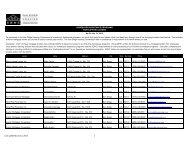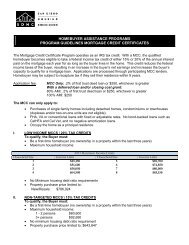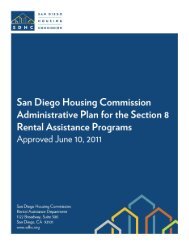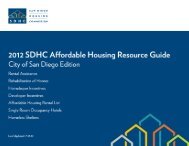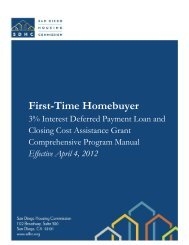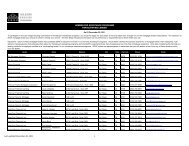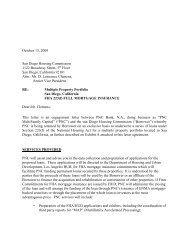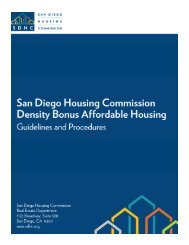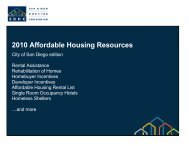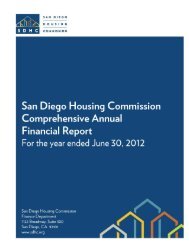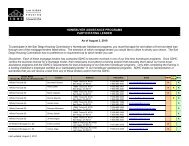Chapter 1 - San Diego Housing Commission
Chapter 1 - San Diego Housing Commission
Chapter 1 - San Diego Housing Commission
Create successful ePaper yourself
Turn your PDF publications into a flip-book with our unique Google optimized e-Paper software.
<strong>Chapter</strong> 9 – Owner Rents, Rent Reasonableness and Payment Standards<br />
[24 CFR Part 982, Subpart I & K]<br />
comparable units, up or down, based on the market value of these factors. The rent for the assisted<br />
unit will be compared to the adjusted rents for the comparable units, enabling a fair, accurate,<br />
market-based determination of rent reasonableness.<br />
After examining and analyzing a comparison of the assisted unit and comparable units, the<br />
professional judgment of SDHC staff is the final determinant of rent reasonableness. SDHC will<br />
consider the degree of similarity with the comparable units, whether the comparable units are a<br />
good match for the assisted unit and the level of adjustment that is needed to make the<br />
comparables “fit” the subject unit. SDHC will also consider the average of the adjusted monthly<br />
rents of the comparable units as an estimate of what might be a reasonable market rent, although<br />
the average is not intended to set an upper or lower limit on an approvable rent. The approved rent<br />
will be based on the general open market rent for comparable units and not based on the few<br />
exceptions that may rent for more.<br />
SDHC will notify the owner of the recommended rent amount based upon its analysis of rents for<br />
comparable units. If the owner disagrees with this analysis, the owner may submit information for<br />
three (3) comparable unassisted units within a two (2) mile radius from the assisted unit. These<br />
unassisted units must be from different complexes and preferably under different ownership. SDHC<br />
will consider this information and notify the owner of a final rent determination.<br />
When requesting a rent increase, the owner must provide the addresses for two (2) unassisted units<br />
in the same complex, which have the same number of bedrooms, have a similar length of tenancy as<br />
the assisted unit, and that rent for the requested amount or more.<br />
E. MOVING FORWARD: INCREASING THE PAYMENT STANDARDS IN LOW-POVERTY<br />
AREAS<br />
In an effort to enhance opportunities for Moving Forward participants in employment and education<br />
and to increase housing choices for low-income participants, SDHC may apply higher payment standards<br />
in targeted low-poverty neighborhoods. Payment standards may be set below or above the 90 percent<br />
to 110 percent range of the FMR without prior HUD approval.<br />
F. PAYMENT STANDARDS FOR THE VOUCHER PROGRAM [24 CFR 982.503]<br />
The Payment Standard is used to calculate the housing assistance payment for a family. SDHC reviews<br />
the appropriateness of the Payment Standard annually at the time HUD publishes the FMR. In<br />
determining whether a change is needed, SDHC will ensure that the Payment Standard is always within<br />
the range of 90 percent to 110 percent of the new FMR, unless HUD has approved an exception<br />
payment standard.<br />
For each FMR area, SDHC will establish payment standard amounts for each unit size. SDHC may have a<br />
higher payment standard within SDHC’s jurisdiction if needed to expand housing opportunities outside<br />
areas of low income and poverty concentration, as long as the payment standard is within the 90-110<br />
percent range of the FMR. See Section D for Moving Forward participants.<br />
SDHC may approve a higher payment standard within the basic range, if required as a reasonable<br />
accommodation for a family that includes a person with a disability.<br />
9-3




